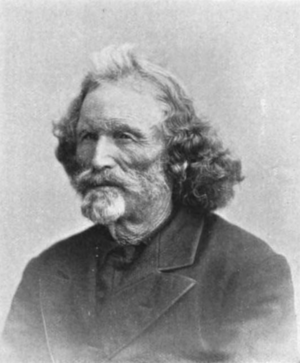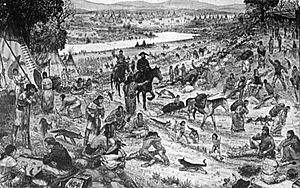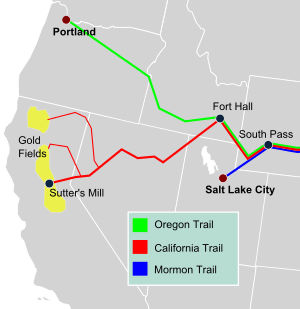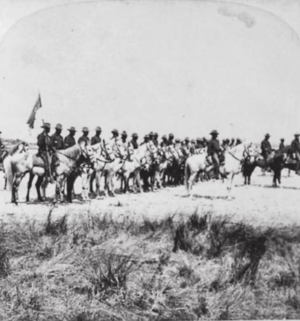Jim Baker (frontiersman) facts for kids
Quick facts for kids
Jim Baker
|
|
|---|---|

65 years of age, ca. 1883
|
|
| Born | December 19, 1818 |
| Died | May 15, 1898 (aged 79) |
| Resting place | Baker Cemetery, Savery, Carbon County, Wyoming |
| Nationality | American |
| Other names | Honest Jim Baker |
| Occupation | frontiersman, trapper, hunter, fur trader, army scout, rancher |
| Employer | American Fur Company |
| Known for | Being a fur trapper and hunter, with Jim Bridger and Kit Carson, and a U.S. Army scout and Indian interpreter, for Generals William S. Harney, Albert S. Johnston, and George Custer |
| Spouse(s) | Married to least three Native American women:
|
| Children | 14 |
Jim Baker (1818–1898), also known as "Honest Jim Baker", was a famous frontiersman, trapper, hunter, and army scout. He also worked as an interpreter and later became a rancher.
Jim Baker started his adventures as a trapper and hunter. Even when the fur trade slowed down in the 1840s, he kept working until 1855. During these years, he became good friends with other well-known figures like Jim Bridger and Kit Carson. In 1841, he was part of a group of trappers attacked by Native American tribes at a place now called Battle Mountain. After their leader was killed, Baker bravely organized the trappers to fight back.
He became an expert guide, leader, and marksman. He was also skilled at communicating with Native American tribes. Later, he worked for the military as a tracker and guide. He helped during the Utah War and after the Meeker Massacre. He also served in the Battle of the Rosebud.
Jim Baker had at least three Native American wives and fourteen children. In 1859, he settled near what is now Denver. This area became known as Baker's Crossing. He started several businesses there, including raising cattle and running a coal mine. In 1873, he built a special cabin in Wyoming that looked like a fort. He lived there, raising livestock, until he passed away in 1898. His cabin is now a museum in Savery, Wyoming.
Contents
Early Life and First Adventures
James Baker was born on December 19, 1818, in Belleville, Illinois. This was close to St. Louis, Missouri. His parents, Phoebe Neeley and William Baker, were farmers from Tennessee. They had eight children.
As a child, Jim learned to hunt and fish. He and his siblings did not get much formal schooling. When he was seventeen, his father sent him to St. Louis for more education. But Jim wasn't interested in school. He dreamed of living on the frontier. So, he went to the American Fur Company in St. Louis to become a trapper.
Life as a Fur Trapper

In 1838, Jim Bridger hired Baker to work for the American Fur Company. Baker earned $465 for 18 months of work (which was like equivalent to $12,779 in 2022 today). He traveled up the Mississippi and Missouri Rivers to the Uinta Mountains. Baker led a group of pack horses to the Rocky Mountain Rendezvous. This was a big meeting where trappers sold their furs and bought supplies. He hunted with Bridger and Kit Carson. After his first contract, he signed up for several more years.
In 1841, Baker joined the Bartleson–Bidwell Party. This was the first wagon train to travel overland on the Oregon Trail to California. While on the Green River, Baker was sent to find his friend Henry Fraeb. Fraeb's group was found near the border of Wyoming and Colorado.
On August 21, 1841, Baker was hunting near Fraeb's camp. Suddenly, 500 Arapaho, Cheyenne, and Sioux warriors attacked the 23 trappers. When Fraeb was killed, Baker bravely took charge. The battle lasted for several days. The trappers used dead horses and logs to create a defense. Four trappers died, and many horses were lost on both sides. This mountain was later named Battle Mountain.
Baker continued to hunt and trap on his own. He often worked with Kit Carson and Jim Bridger. He got along well with the Shoshone people. However, the Arapaho and Snake sometimes stole their furs. Baker became known for his amazing skills as a frontiersman. He was an excellent marksman, archer, and horseman. He could also throw a lariat (a type of rope) very well.
Jim Baker was also skilled at Plains Indian Sign Language. He spoke several Native American languages. He was known for his ability to guide people even where there were no clear trails. He knew the western lands very well. Because of his reputation, he became good friends with John C. Frémont.
Baker lived with the Shoshone tribe in the Wind River Basin. He adopted their clothing and way of life. In 1847, he rescued Marina, the daughter of the Shoshone chief, from the Blackfeet tribe. He married Marina in October 1847. She gave him a bear claw necklace as a symbol of bravery. Baker was adopted into the Shoshone tribe and called "Red-Haired Shoshone." He fought in battles against the Cheyenne, Sioux, and Crows. People said he was never wounded, but also that his body had many scars from battles and accidents.
It became harder to make a living from trapping. By the 1840s, many beavers had been trapped. Also, silk hats became popular, so there was less demand for beaver fur hats.
Baker ran a trading post and ferry stop on the Oregon Trail, California Trail, and Mormon Trail. These trails were used by many people moving west. As Mormons settled in the area, there was competition for land and resources. Baker ended his career as a trapper and hunter in 1855.
Scout and Guide
Jim Baker worked as a guide and interpreter for 34 years. In 1845, he helped move 4,000 wild horses from what is now Southern California. In 1847, he worked as a scout for a railroad party near Salt Lake City.
In 1855, Baker became the chief scout at Fort Laramie. He served under General William S. Harney. Two years later, he guided Colonel Albert Sidney Johnston and his troops during the Utah War (1857–1858). Baker led a group through Colorado to New Mexico to buy mules. They faced very cold weather and deep snow. Captain R.B. Marcy said they would have died without Baker's expert leadership. On their way back, they discovered gold near Cherry Creek in 1858.
Later, Baker was injured when his Spencer carbine exploded. His face, chest, and right lung were hurt, and he lost his right thumb. He was treated by a surgeon near present-day Denver.
Life in Colorado and Wyoming
On July 3, 1859, Baker settled west of Denver along Clear Creek. This area became known as Baker's Crossing. He started several businesses there. He built an adobe house and raised cattle. He also ran a coal mine, a toll bridge on the Denver Boulder Wagon Road, and a store. His customers included both European American settlers and Native Americans.
In 1864, Baker became a captain in the Colorado Militia. He also worked as a guide for Indian Agent Daniel Chessman Oakes.
In 1873, Baker moved from Colorado to a ranch near Savery, Wyoming. He built a log cabin that looked like a fort. This cabin later served as a safe place for settlers after the Meeker Massacre in 1879. Baker raised cattle and branded them with "JB".
He guided an Indian agent and later guided Colonel Wesley Merritt after the massacre. Baker also served under General George Armstrong Custer during the Battle of the Rosebud in 1875. This battle was against Crazy Horse and the Oglala Lakota tribe. After the Meeker Massacre, Baker was hired to track the Utes responsible for the attack.
Family and Final Years
Jim Baker was married at least three times, and possibly more. He had wives from the Shoshone, Snake, Bannock, and Flathood tribes. He was the father of 14 children.
His first wife was Marina, the daughter of Shoshone chief Washakie. They married in October 1847 and had three children: Jennieve Jane, William, and Joseph. Marina and some of their children died from smallpox in 1852 while Baker was away.
He later married Meeteetse, a Shoshone woman he called Mary. They had ten children. With another wife, Eliza Yanetse, he had a daughter named Jennie. In 1856, Eliza had twins, but only one, James C. Baker, survived.
In 1873, Baker moved to his two-story cabin near Savery, Wyoming. The first floor was for living, and the second floor was for storage or where Baker slept. Until 1881, his cabin had a watchtower on top, offering a great view of the valley. Shoshone, Ute, and Snake people lived in tipis nearby. By this time, only six of his children lived with him:
- William settled near Dixon, Wyoming.
- Joseph lived with Baker for a time, then moved to the Shoshone Reservation.
- Mary married John Runnels.
- Isabelle married N.B. Kinnear.
- Madeline married Frank Adams.
- Jennie married August Rischke.
Jim Baker continued to live at his cattle ranch and cabin. He passed away on May 15, 1898, at his cabin. He was buried in a family cemetery at the base of Baker's Peak, a mountain named after him.
Legacy
In 1917, Jim Baker's cabin was moved to Frontier Park in Cheyenne, Wyoming. But in 1976, it was brought back to Savery, Wyoming. It is now part of the Little Snake River Museum. Jim Baker's great-grandson, Paul McAllister, helped rebuild the cabin. A statue of Baker was made for Westminster, Colorado. His portrait is also in a stained glass window at the Colorado State Capitol building in Denver.




